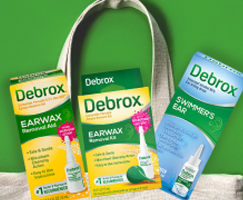Ear Care Education
Top 5 Things You Didn’t Know About Earwax

If you grew up thinking earwax is kind of icky and gross, you’re not alone. There’s nothing cute about finding a gooey yellow substance in your ears. Yuck! But earwax is actually very helpful to your overall health.
Think of your ears as a self-cleaning oven. Things like chewing and talking keep your jaw in motion. That motion churns your earwax and keeps it moving.
So while your earwax may look gross, it’s constantly working as a protective barrier to keep your ears healthy and happy. Let’s take a look at a few other earwax facts that might just surprise you.
# 1 - What is earwax made of?
Our bodies naturally produce all kinds of secretions that we just accept as normal. But if you really think about it, how do we produce earwax? Where exactly does it come from?
Earwax is made up of sloughed skin and hair cells and debris that gets trapped in our ear canals. The medical term for it is cerumen. It can be yellow, orange or even grayish. Earwax provides more than protection, it keeps your ears properly lubricated. That means they don’t feel dry and itchy. Plus, studies of human cerumen reveal it reduces effects of many potentially harmful bacteria and fungi.
#2 - Earwax is sticky for a reason
If you’ve dealt with earwax, you know it’s super sticky like a little glob of glue. Well, you’ll be happy to know it’s sticky for a good reason. Your earwax protects your ear canals from dryness, bacteria, environmental debris and dirt, but it also protects your ears from little insects.
Yep, your earwax is natural bug repellent! It actually has an odor to tiny insects that keeps them away from your ears. If a small bug tries to crawl inside, your earwax acts like fly paper, so the insect gets stuck.
# 3 - Your earwax says things about you
The appearance of your earwax can tell you a little something about your health. If you have children, you may remember they’d usually have soft, orange or yellow earwax. That’s totally normal and indicates good healthy earwax production. Adults tend to have harder earwax that is darker. The darker color is due to more dirt and bacteria being trapped.
If you see dark brown earwax tinged with red, that can indicate a bleeding injury. If your earwax is runny and cloudy, that can indicate an infection in the ear canal. If it’s black, that can indicate a serious blockage or a foreign object is trapped in your ear canal. In that case, an immediate visit to the doctor is required.
#4 - Enter at your own risk
You’ve probably heard the saying, “don’t put anything in your ear smaller than your elbow.” Many people make the mistake of using cotton swabs the wrong way. Sure, you can swab the outer creases of your ear, but you’re never supposed to put anything deeper in your ear canal. That plan can backfire by pushing earwax deeper into your ear canal, causing greater buildup or damage your ear drum.
It may be tempting to mess with it, but you’re supposed to leave earwax alone. It naturally dries up or flakes off on its own. No cotton swabs required!
#5 - When enough is too much
Earwax can become problematic when your body is producing too much of it and it’s not self-cleaning fast enough to keep our ear canal clear. Too much earwax can result in a blockage that may cause discomfort or hearing loss. This occurs more frequently in older adults.
Whatever you do, don’t reach for a cotton swab, because that could make things worse! A safe way to remove earwax buildup is to use Debrox, the #1 doctor recommended brand in the United States. Debrox® removes excessive earwax through the power of microfoam cleansing action.
To use Debrox®, place 5-10 drops in the affected ear(s). You may hear a temporary crackling or fizzing sound, which is normal. It’s just the sound of the drops working their magic. After the earwax drains, you can use warm water to gently flush out any remaining earwax.

